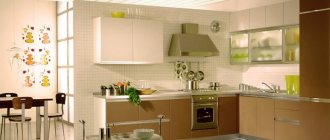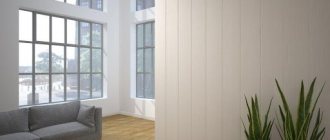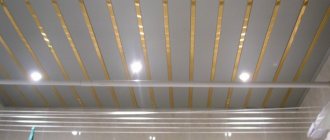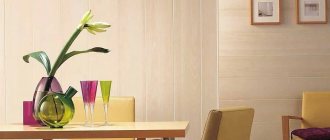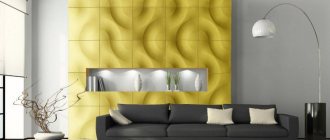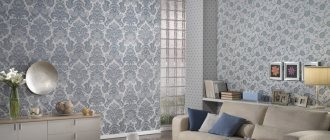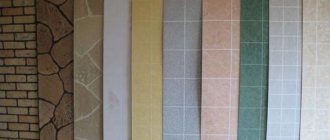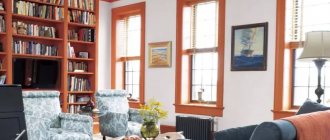Mirror panels have found their application not only in commercial but also in residential premises. Any room in the house is transformed by decorating the ceiling and walls with mirrored surfaces.
Use in the apartment:
- In bathroom;
- hallways;
- living rooms;
- in the bedrooms;
- in kitchens;
The interior of the kitchen space is transformed when mirrors appear in it, but this also requires careful care. The solution to the cleaning issue is a glass surface cleaner.
In commercial spaces, mirror plastics are used:
- in shops;
- in bars, cafes, restaurants;
- in fitness clubs, dance studios;
Reflective surfaces significantly expand and complicate the interior:
- The height of the room visually increases when such materials are glued to the ceiling.
- The room expands when used on the walls.
The panels are used to decorate walls, ceilings, furniture, columns, doorways (including arched ones), and kitchen aprons.
Advantages and disadvantages
Pros:
- Easy to install on a variety of surfaces.
- A small room is enlarged.
- Easy to care for.
- Flexible, easily mounted on curved surfaces (arches, columns, furniture parts).
- Pairs perfectly with other decorative elements.
- Improves soundproofing of apartments.
- They come in various colors (colorless, tinted or antique mirror) and have perforations. Sheet plastics can also imitate a mirror consisting of many small tiles.
- If desired, printing and decor can be applied to the reflective side.
Minuses:
- Highly flammable (cannot be installed near a source of elevated temperature).
- The surface for applying such decor must be flat (otherwise the reflection will be distorted).
- It cannot always be used in finishing spaces with high humidity; direct contact with water must be avoided.
- You cannot build in high-power lighting fixtures (for example, when gluing mirror panels to the ceiling) if the reflective plane of the plastic does not have a special protective coating.
Advantages of plastic mirror materials
Mirror plastic has many advantages:
- It has high reflectivity.
- The plastic material is resistant to ultraviolet radiation and external conditions. It does not lose strength and does not turn yellow even after prolonged exposure to adverse weather conditions, acids, alkalis, salts, and inorganic components.
- Mirror plastic also demonstrates resistance to pathogenic microorganisms, which makes it possible to use it in conditions of high humidity.
- The material is much lighter than glass. It does not require the use of additional supports, which creates a feeling of open space.
- Mirror plastic is easy to process.
- It is environmentally friendly and does not emit toxic components when burned.
- There is increased resistance to breaking and impact.
The material has a wide range of applications. It is used in decoration, repair and construction, advertising, production of all kinds of structures and other creative solutions.
What are they?
Technology is developing at a tremendous speed and there is a huge variety of substances on the market from which panels are made.
The main materials from which mirror tiles are made:
- Acrylic. This is the most common material for panels (plexiglass, plexiglass). According to the manufacturing method, plexiglass can be extruded and cast, but in terms of characteristics they are almost the same and have the following properties:
- high impact resistance;
- increased moisture resistance;
- high heat resistance;
- 5-6 times stronger than ordinary glass;
- good UV resistance;
- the most transparent polymer;
- high specularity (98%);
- not very resistant to damage to the outer layer, scratches easily;
- maximum sheet size 3050 x 2050 mm, thickness 2 mm or 3 mm;
- Polystyrene. This is a composite material with rubber. Properties of mirror decors made of polystyrene:
- flexible;
- resistant to chemical influences;
- high resistance to impact, microcracks do not form due to the presence of rubber;
- can be used at elevated temperatures (up to +70);
- perfectly imitate a mirror;
- easy to handle;
- 100% moisture resistance (the ends of the sheets must be protected from water so that the material does not delaminate);
- Polystyrene sheets are available in thicknesses from 1.0 to 3.0 mm. If they are thicker, they will become less flexible, more rigid and brittle;
- Plastic. One of the main materials for any finishing panels. Has the following characteristics:
- moisture resistance (does not deform even with direct contact with water);
- resistant to chemicals;
- elasticity;
- environmental safety, harmlessness to humans;
- easy to care for;
- shockproof;
- easy to drill, bend, saw with a simple tool;
Plastic panels with a self-adhesive base are available in the form of tiles and also in rolls. To the advantages of all types of materials considered, one can add ease of installation, without dirt.
PVC panels with mirror effect
Mirror plastic based on polyvinyl chloride (PVC) is today one of the most widely used polymer materials used in interior decoration, the manufacture of plaques and signs. Thanks to the perfectly smooth surface, a mirror film is applied to the PVC sheet, which is the working surface. A layer of protective varnish is applied on top.
The features of this plastic include the following qualities:
- impact resistance and moisture resistance. It practically does not absorb water and moisture from the air. It is able to withstand even direct contact with water, does not swell, does not deform, which allows the use of PVC-based mirror plastic in bathrooms and kitchens.
- PVC plastics are resistant to a large number of chemicals, solutions of acids and alkalis, and household chemicals. They have increased fire safety.
- The material can be easily processed with conventional tools. It can be drilled, sawed, bent, milled, and secured with screws.
- PVC-based plastics have high elasticity, which makes it possible to manufacture products of complex shapes from them.
- They are well glued using solvents and special compounds, welded in a heated state using hand-held hair dryers or end-to-end on special machines.
- PVC plastic does not contain heavy metals, is environmentally friendly and has no harmful effects on the human body and the environment. The absence of pores on the surface of the panels does not allow pathogens to accumulate.
- They are easy to clean using detergents that do not contain chlorine.
Mirror PVC plastic is available in the form:
- PVC ceiling panels, painted silver or gold and varnished. On the reverse side, under the protective film, a sticky layer has already been applied. If there is no self-adhesive layer, then a PVA-based composition is used for installation. When installing a ceiling made of PVC panels, it should be taken into account that high-power lighting lamps cannot be used, since it is not recommended to heat the plastic too much;
- self-adhesive PVC panels. This is a rolled material with a pre-applied layer of glue. Can be used on any prepared surface;
- PVC mirror film for suspended ceilings. Mirrored stretch ceilings based on this film have excellent performance qualities: high moisture resistance, fire resistance, and dust repellency. Caring for mirrored ceilings made of plastic comes down to regular periodic washing with glass washing liquid or soap solution.
Currently, mirror plastics from the following manufacturers are most widely represented on the domestic market: Plexiglas Mirror (Germany), AULEN (China), Saispecchi Srl (Italy), Gebau (Russia), Metzler (Germany) and Zuroplast, Sibu (Austria), E- Plast (Russia).
How and which ones to choose?
PVC panels
Plastic panels have stiffening ribs in their design, and the strength of the decorative sheet material depends on them.
Criterias of choice:
- The stiffening ribs should not be visible on the front side.
- The more ribs, the more stable the product.
- The plane should be smooth and even.
- The thicker the outer surface, the better the quality of the panel.
- High quality joining groove.
- The packaging of finishing materials must be intact.
Plastic panels are used in decorating spaces and making signs.
Acrylic
Acrylic plastics are used for the production of wardrobe doors, outdoor advertising, and signs. Can be used anywhere in the interior, even in the bathroom and kitchen. But I didn’t find any use in the exterior, because... Each layer of the sheet has a different degree of expansion and contraction with temperature changes. Self-adhesive acrylic panels can be used in rooms exposed to a lot of UV rays.
Polystyrene panels
Polystyrene tiles are also used only inside rooms (for example, for ceilings); they are used in the manufacture of advertising, signs, and decorations.
Methods for attaching acrylic material
There are three main ways to attach material.
Liquid Nails
In this method, it is important that the base is level. It needs to be cleaned of dust and hardware. Before installing the sheet, it must be degreased using an alcohol base . Liquid nails are distributed pointwise over the entire surface. For the purpose of fastening, the prepared decorative element is applied to the base and lightly pressed against the base.
When using this method on an uneven surface, the mirror surface may be deformed, which cannot be corrected. If the differences are insignificant, a sheet 3 mm thick is taken. It is quite dense and not too elastic, so small errors will not spoil the surface.
U-shaped fastenings
U-shaped fasteners can be used as a fastener if you need to create mirrored arched and window openings on a solid surface. This method can be used to finish fences. The decor is attached to the concrete base using dowels, and to the wooden base - with self-tapping screws .
It is recommended to frame polymer elements around the perimeter to prevent surface deformation due to external factors.
Hidden fixation
If you need to create a monolithic surface or invisible joining of several sheets, you can use special plates called hidden fasteners . Their advantage is that the fastening is truly invisible, so it will not spoil the finished product.
Mirror plastic is a material with high quality characteristics that provides unlimited possibilities for design, repair, and construction. Its correct selection and fastening will allow even the most daring ideas to come true.
Prices
Depending on the substance from which mirror sheet plastics with an adhesive layer are made, the manufacturer, the size and thickness of the sheet, the cost varies:
- Acrylic: on average from 5,000 to 20,000 rubles.
- Polystyrene: vary from 1,500 to 10,000 rubles.
- PVC: for most manufacturers from 4,000 to 10,000 rubles.
Price and sheet size
Acrylic:
- 1220 x 2440 x 2 mm 5000 rub.;
- 1220 x 2440 x 3mm RUB 6,000;
- 2050 x 3050 x 3mm 14,000-16,000 rub.;
- 3050 x 2050 x 2mm 12,000-15,000 rub.;
Polystyrene:
- 1000 x 2000 x 1 mm 1500-1700 rub.;
- 1000 x 2000 x 2 mm 2500-2800 rub.;
- 1220 x 2440 x 1.5 mm 2500 rub.;
- 1220 x 2440 x 2 mm 3000 rub.;
- 1220 x 3000 x 2 mm 6000 RUR;
- 1220 x 3000 x 3 mm 8000 rub.;
Plastic:
- 1000 x 1000 x 1.2 mm 5000 rub.;
- 3000 x 1000 x 2 mm 8000 rub.;
To give an example of the cost of self-adhesive mirror panels, average prices in various retail stores were taken.
Dimensions
The variety of sizes of mirror plastic is enormous, considering that these are different materials, which are also produced by numerous manufacturers around the globe. For example, polymethyl methacrylate can be found in the form of sheets of various sizes and shapes, but with dimensions no more than 305 by 205 cm. The thickness is relatively small - only 2-3 mm. The adhesive base may or may not be present.
Mirror polystyrene, despite its flexibility, is also sold not in roll form, but in sheets. At the same time, the fragments are slightly smaller - it is difficult to find a sheet larger than 300 by 122 cm on sale. The thickness of the product ranges from 1 to 3 mm, and here you still need to think about the choice: a sheet that is too large a priori cannot be thin, but increasing the thickness negatively affects flexibility and increases fragility.
PVC sheets of the standard type are characterized by a small thickness - often at the level of 1 mm. Their dimensions are the most modest - up to 100 by 260 cm.
Installation Features
It would seem that it could be easier to mount plastics on a self-adhesive base - peel off the protective film of the adhesive base and glue it to the surface?
But this process requires compliance with some rules:
- SurfaceThe surface on which the sheets are glued must be absolutely flat and clean. Otherwise there will be distortions on the mirror. Can be glued to various finishing textures:
- concrete;
- tree;
- stone;
- cardboard;
- Rolled plastics , like linoleum, must be rolled out on a flat surface at least a day before use. This is necessary so that the material straightens. If this is not done, then it will simply not be possible to glue such panels well. There is no need to place heavy objects on top for better straightening, otherwise dents and scratches will remain.
- When installing mirror sheets, you need to take into account the natural expansion and contraction of the composite with temperature changes. To do this, leave a gap between the panels. The minimum gap is 0.5 mm. If there may be significant temperature changes in the room, then you can make a gap of up to 1 mm. Visually, it is not noticeable that the adjacent panels are not glued end-to-end. But you can be completely sure that the plastic will not swell.
- Sheet plastic is cut from the front side. Polystyrene tiles are best processed with high-speed tools. Before starting work, remove the protective film from the processing area. To reduce the likelihood of overheating and deformation of the material, you need to cool the surface at the sawing site.
Mirror polystyrene
Impact-resistant polystyrene sheet is another common type of polymer mirror. As a rule, a polystyrene composite with synthetic rubber is used as the starting material for applying a mirror coating. The presence of the latter reduces the likelihood of microscopic cracks appearing on the surface of the material, increases strength and reliability of operation.
As a reflective element, a mirror polyester film coated with aluminum is glued onto the polystyrene sheet.
Unlike acrylic, polystyrene is not transparent, so the mirror coating is applied on the working side of the material, which acts as a base. To avoid damage to the coating, an additional protective film is applied on top of it.
Mirror polystyrene sheets are characterized by a high degree of flexibility and strength. The upper temperature limit at which polystyrene retains its technical characteristics is +70 degrees. The material resists impacts, scratches and cuts well. It is not destroyed by contact with chemically aggressive environments.
Processing mirror polystyrene is not difficult, but when cutting and drilling, it is necessary to take into account that the most vulnerable point of the composite is the surface of the connection between the polymer base and the reflective film.
To avoid breaking contact between layers when working with the material, the following rules should be followed:
- to make holes, use high-speed drilling equipment, and drill from the side of the mirror film;
- cutting with a laser tool is carried out from the uncoated polystyrene side;
- when cutting with a mechanical tool, clean the line of the planned cut from the protective coating;
- The material can be glued to various surfaces. For this purpose, special adhesive compositions based on neoprene are used;
- It is not recommended to bend sheets of mirror polystyrene using local heating, as this can lead to peeling of the polyester film.
When using the material, you must ensure that moisture and water do not get on the unprotected ends of the sheets. The surface of composite polystyrene is cared for using a sponge moistened with acrylic glass cleaner.
Mirror polystyrene has found wide application for the manufacture of decorations, interior design elements, and advertising and information structures. Due to its small thickness and good flexibility, polystyrene is used for finishing surfaces with curvature.
Recommendations
A few tips to expand your room with mirror panels:
- The interior should be bright.
- If a large window is reflected in the mirror, the space will expand. When reflective walls are placed opposite each other, a tunnel effect is created and the boundaries of the room will change.
- Don't frame the space with lots of mirror tiles (this will reduce the size of the wall).
- Reflective sheets can be glued to the ceiling to create the effect of a higher space.
- If the mirror surface becomes dirty, you can bring it back to perfect condition with a regular window cleaner.
Mirror acrylic
Among other types of plastic, polymethyl methacrylate (also called plexiglass or acrylic) stands out:
- high transparency;
- strength and impact resistance;
- ease;
- moisture resistance;
- possibility of operation under the influence of ultraviolet radiation;
- high reflectivity (up to 98%) and image brightness without distortion.
Among the negative characteristics of acrylic are its softness and susceptibility to scratches . This drawback is eliminated by applying a protective coating to the surface of the plexiglass on the side opposite to the mirror layer.
The reverse side of the amalgam acrylic mirror is also protected with a special coating and painted in various colors. The polymer is used for interior decoration (mirror panels of suspended ceilings and walls, sliding door systems, furniture inserts).
There is a type of acrylic material with an adhesive base (mirror plastic is self-adhesive).
The material is suitable for processing with hand and electric tools, however, when working with it, it is necessary to take into account the uneven heating of the acrylic base and the amalgam layer. To avoid deformation of the polymer during the cutting process, it is necessary to provide for the possibility of cooling the cut surface.
Comparison of prices for mirror plastics
| Material | Price, rub./m2 |
| Glass mirror, 4 mm | 500-700 |
| Aluminum composite panels, mirror surface 3(0.3) | 1250 |
| Acrylic mirror | 2500 |
| Impact-resistant mirror polystyrene | 1200 |
| Self-adhesive film ORACAL 352 | 400 |
The table shows that a classic mirror made of silicate glass is cheaper than alternative mirror plastics. But if safety, ease of processing, light weight, and impact resistance are important, then you cannot do without modern polymer materials.
Glass processing methods
Mirror panel for a wall
The construction of a solid wall of mirror panels is a rather bold decision, so designers use products that have special processing aimed at highlighting each mirror element and allowing to smooth out the reflective effect. The same principle is used when creating decorative mirror panels.
Beveled tiles
Framing a false fireplace niche
This is the most popular method of processing the material, which gives the wall a more complex relief. A bevel is a beveled edge of a mirror panel.
Due to the facets, each element acquires additional volume and becomes, as it were, convex, while the edges also have a reflective effect and create a play of light flows that are refracted in them.
For a mirrored wall opposite the bed, it is advisable to reduce the reflection effect
In a bright bedroom in a minimalist style, a beveled wall can be used at the head of the bed. At the same time, psychological discomfort will be reduced, and thanks to the facet cutting of the tiles, the effect of fragmenting the space will be eliminated. Since nothing will interfere with the reflection of lighting fixtures, the room will be bright and light.
Decorating the dining area in the kitchen
Note! The layout of beveled tiles can be represented by rhombuses or rectangles of the same or different shapes.
The larger the beveled edge, the less reflective the mirror tile becomes. As a result, the effect of duplicating space is practically eliminated, but the visual expansion of space is preserved.
Emphasis on joints
Accentuating joints with frames
In this case, gaps are left between the mirror elements or additional edging and framing are used to imitate them. To create a similar effect, it is possible to use wooden slats and beads, plasterboard moldings, wooden, plastic or metal frames. At the same time, using a frame, you can decorate each mirror tile in the form of a picture.
Kingdom of Crooked Mirrors
Tinted mirrors
To create the effect of distracted attention, mirrors with a fuzzy or curved reflection are used. They are obtained using special heat treatment. As with the facet, the effect of expanding space is fully preserved.
What it is?
Just the name of a material (or rather, a group of materials) already fully reveals the essence of what it is. Mirror plastic is a polymer created in the laboratory that has such high reflective properties that from the outside it appears to be a mirror. The logic of using such a material is obvious: a plastic product is often more resistant to impacts, and in addition, it is safer due to the fact that when destroyed it does not produce sharp fragments.
Mirror plastic is also often called plexiglass, although the second concept is broader - it means any materials that resemble glass, but they can also be transparent, while the material we are considering reflects surrounding objects no worse than a real mirror.
